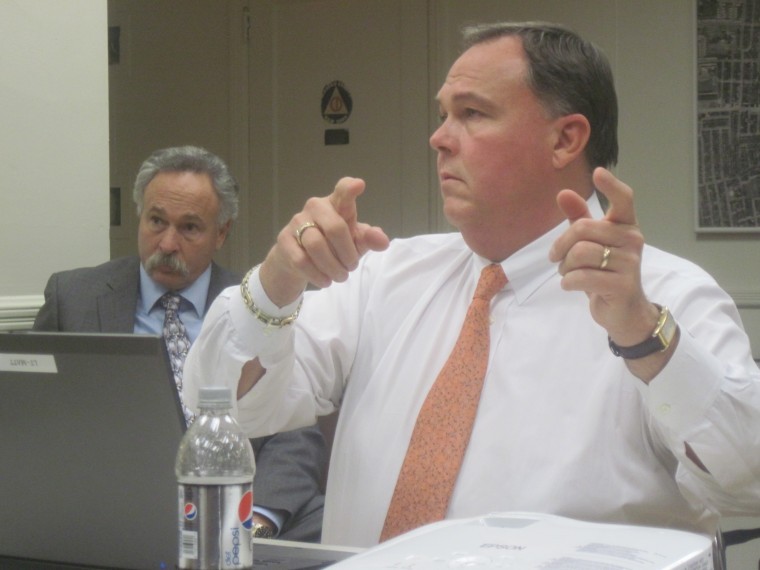Village of Williston Park consultants said Monday the village was on the verge of implementing a property revaluation that would replace “archaic” tax rolls that had not been adjusted in 80 years with a values that properly balanced residential and commercial property rates.
“Our values – what your taxes are based on – are going to be a lot fairer than what you started with,” said Matthew Smith, president of Standard Evaluation Services. “We had some serious flaws in your commercial base and we feel we’ve corrected that.”
Smith and a second consultant, who spoke at a special meeting to inform residents about the village-wide property revaluation, said the village’s revaluation was nearly complete.
At the outset of the meeting, Williston Park Mayor Paul Ehrbar said the village had spent $38,000 in legal fees last year to defend challenges to the village’s commercial property assessments and that the village has paid $530,000 in tax certiorari refunds in the past three years,
“We’re trying to level the playing field for everybody across the village. A lot of people are happy. A lot of people aren’t happy,” Ehrbar said.
Smith said the split between residential and commercial taxes was now set at ratio of 82 percent and 18 percent, under a Homestead Law adopted by the village board. It was intended to ensure that adjustments in commercial valuation rates would not increase the tax burden for residential property owners, as had been the case in the past.
All properties are being reassessed at 100 percent of their value.
A review of the revaluation shows that 85.6 percent of residential properties will see their taxes increase by $300 or less, with 14.4 percent of taxes on residences changing by $300 or more, according to Smith. He said taxes for 1.5 percent of residential property owners went up by $500 or more.
Smith said the residential areas of the village were divided into six segments based on age and type of house. The current county system divides the village into two segments, which are included with Herricks and Mineola.
Approximately 40 residents gathered at the meeting to hear an overview of the results, pose questions, and in some cases complain about the revised values of their properties.
Those who raised questions were clearly not happy with their reassessments.
Some residents objected strongly to the revisions they’d seen in the corrected assessments they had received by mail just after Thanksgiving.
“This is all out of whack,” one resident said, telling Smith, “If you move your lips, you’re lying.”
The resident said his property valuation had soared from $335,000 to $437,000.
Ehrbar cautioned the residents against making any personal attacks and repeatedly said that residents with issues about the revaluations of their properties should make an appointment with Standard Evaluation Services to seek redress.
Local realtor Evelyn Atanas said she saw an inconsistency with residential properties abutting commercial properties and the Long Island Railroad line being valued the same as residences in adjacent areas. She said that prices on recent house sales in the village ranged from $300,000 to $400,000 or $500,000, with average prices falling in a range above $400,000.
“They’re not holding up as they did before,” she said, adding that Cape Cod style houses and Chatlos colonials in the northeast part of the village are currently the best selling properties.
One unhappy resident whose valuation had risen by $100,000 told Smith, “If you think my home is worth that much, I’ll go home and get my deed to and let you buy it.”
That drew laughs from those gathered in the third floor meeting room of Village Hall.
The mayor told residents that they still have until Dec. 16 to set up individual meetings with executive of Standard Evaluation Services to seek amended assessments.
Tom Donato, project manager of Michael Haberman Associates, a second consulting firm hired by the village, said the village’s tax rolls had long been out of date.
Smith said his company also had corrected what he termed a wide “value spread” in residential properties, based partly on sales of homes in Williston Park from 2008 through the present. That methodology was used because of the limited data from current home sales in the sluggish residential sales market.
Smith noted the revaluation was aided by a strong 53.7 percent response rate from data mailer sent to residents who provided updated descriptions of their properties. Assessment values were also adjusted to reflect the decline in real estate values in recent years.
“This actually protects the residents,” Trustee Teresa Thomann said. “We haven’t looked at this in 80 years, so it needed to be reassessed.”
Ehrbar said the revaluation process aimed at helping “both sides in the long run.”



